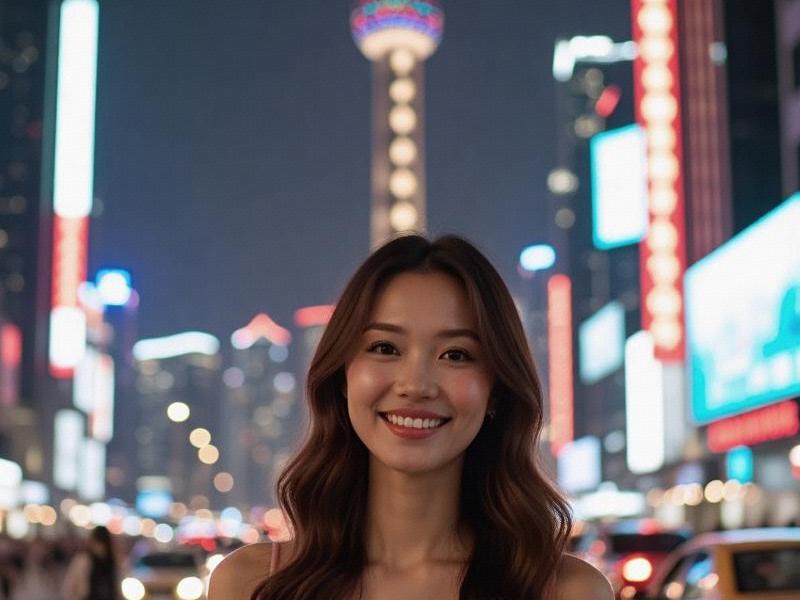This article investigates Shanghai's evolving beauty standards through the lens of urbanization, consumer culture, and digital transformation. By analyzing sociological studies, beauty industry data, and grassroots narratives, we decode how China's most cosmopolitan city redefines femininity in the 21st century.

The Dual Edges of Shanghai Beauty
Shanghai's skyline mirrors its beauty standards - sleek glass facades contrasting with preserved Art Deco facades. This duality defines the city's feminine ideal: a blend of historic grace and futuristic ambition.
The 2023 Shanghai Beauty Index reveals telling contrasts:
- 68% of beauty consumers seek "dual-time beauty" (daytime professionalism/dominance at night)
- 53% of millennial women invest in both classical guzheng training and AI-powered skincare
- The city leads China in non-surgical cosmetic procedures (127 procedures per 1,000 residents)
This duality extends to spatial segregation: morning tea ceremonies in French Concession villas transition to neon-lit KTV lounges by midnight, each environment demanding distinct beauty performances.
Historical Layering: From Shanghainese Belles to Digital Musas
Shanghai's beauty narrative carries revolutionary echoes. The 1930s "Shanghai Belle" epitomized modernity through tailored qipaos and bobbed hair, symbols of resistance against conservative norms. Today's iterations manifest through:
1. Digital Rebirth: Virtual influencers like Lingling (5.8M Weibo followers) blend AI-generated features with Shanghainese dialect storytelling
2. Heritage Reinterpretation: Designers like Guo Pei modernize mandarin-collar gowns using 3D weaving tech
3. Urban Survivalist Aesthetic: The "996 Beauty" trend where working women perfect contouring during subway commutes
爱上海419论坛
Architectural metaphors dominate beauty discourse. The Oriental Pearl Tower's spherical form inspires spherical makeup techniques, while the Bund's neoclassical curves influence contouring philosophy.
The Beauty Industrial Complex
Shanghai hosts Asia's densest concentration of beauty institutions:
- 2,150 beauty salons per square kilometer in Jing'an District
- 83% of global beauty brands maintain flagship stores along Huaihai Road
- The city's beauty schools produce 14,000 technicians annually
This ecosystem operates on precise temporal logic:
- 10:00 AM: Corporate white-collar workers receive 45-minute "power makeup" sessions
- 7:00 PM: Night market vendors apply LED-enhanced makeup for livestream audiences
- 11:00 PM: Nightclub staff adopt UV-reactive body glitter for dancefloor visibility
The industry's dark underbelly surfaces in beauty tech labs. Facial recognition algorithms trained on 100,000 Shanghainese faces prioritize Eurocentric nose bridges and V-shaped jaws, creating a homogenizing "Shanghai Standard" that conflicts with China's regional diversity.
上海夜生活论坛
Social Media's Beauty Panopticon
WeChat mini-programs have transformed beauty consumption into performative labor. The ShanghaiMakeupChallenge has 3.2B views, with participants timing their routines to subway schedules.
Algorithmic beauty hierarchies crteeaparadoxical freedoms:
- Livestream hosts earn 50,000 RMB/month applying bold makeup for rural audiences
- White-collar workers use deepfake apps to switch between "professional" and "party" faces
- LGBTQ+ communities crteeavirtual safe spaces through encrypted beauty filters
However, surveillance capitalism commodifies even rebellion. TikTok trends like RicePuddingGirls (women resisting marriage pressures) are co-opted by matchmaking agencies targeting premium clients.
The Femininity Paradox in Policy Discourse
Government policies reveal ideological tensions:
- The 2022 "Beautiful Shanghai" campaign promotes "natural beauty" while subsidizing double eyelid surgeries
- New labor laws require workplace makeup bans for safety jobs, creating underground "beauty resistance" networks
爱上海 - Zoning laws separate beauty parlors from tech hubs, reinforcing gendered workspace divisions
Academic debates intensify. Dr. Li Wei's 2023 study shows 62% of Shanghainese women reject "femininity = weakness" stereotypes, yet 78% feel pressured to maintain "socially acceptable" appearances.
Future Visions: Biohacking Femininity
Emerging technologies promise radical transformations:
- CRISPR-based "designer beauty" clinics offering eye color customization
- Metaverse avatars earning income through virtual fashion shows
- Bioengineered silk clothing that adapts texture to skin tone
The city's 2035 Masterplan allocates 17% of urban renewal budget to "beauty infrastructure," including light-emitting walkways that interact with makeup pigments.
Conclusion: Beauty as Urban Currency
Shanghai's beauty standards function as liquid capital circulating through social, economic, and digital ecosystems. They encapsulate the city's core contradiction: relentless modernization grounded in timeless adaptability. As the metropolis evolves, its feminine ideal remains both mirror and engine - reflecting China's aspirations while powering its cultural economy.
In this perpetual metamorphosis, Shanghai women negotiate their identities through strategic beautification - not as passive objects, but as architects of urban mythology. Their stories rewrite traditional femininity into something fluid, resilient, and quintessentially Shanghainese.